KINGDOM OF NUMIDIA (Berber) c. 208-118 BC Miscipsa/Massinissa AE26 Coin NGC

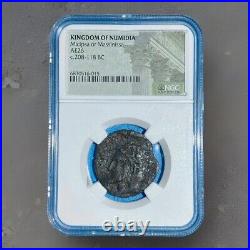

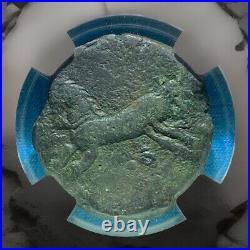
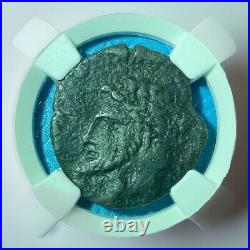

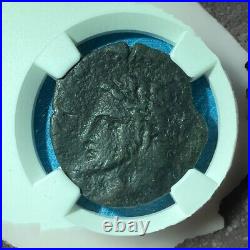



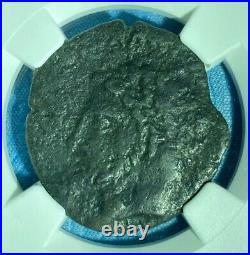
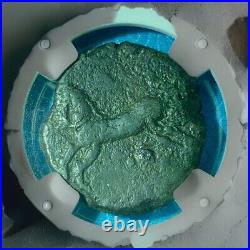


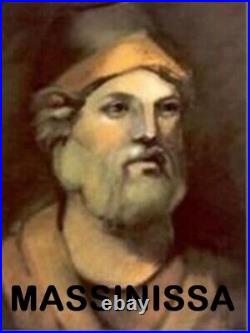
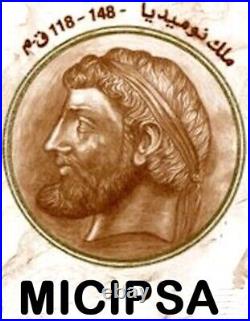


This ancient Greek coin from the Kingdom of Numidia, minted between 208-118 BC, features the bust of Miscipsa or Massinissa on one side and a horse on the other. Made of bronze, this ungraded coin has been certified by NGC with certification number 6830516-015.
Its geographic origin is Ancient Greece, and it was manufactured in the Kingdom of Numidia. Massinissa was an ally of Carthage for most of the Second Punic War, he changed sides and became an ally of Rome in 206 B.
His support was critical for Rome's final victory at Zama, and his continuing friendship with Rome kept Carthage in check between the Second and Third Punic Wars. Micipsa was the son of Massinissa. Massinissa was best known for leading a federation of Massylii Berber tribes during the Second Punic War, ultimately uniting them into a kingdom that became a major regional power in North Africa.
OBVERSE - Laureate and bearded head to left. REVERSE - Horse galloping to left. Masinissa was a king of Numidia, an area of North Africa which surrounded Carthage.
Although a barbarian chief, he was educated at Carthage, and spoke both Latin and Greek. His long and active lifetime spanned both the Second and Third Punic Wars. Although he was an ally of Carthage for most of the Second Punic War, he changed sides and became an ally of Rome in 206 B. It was Masinissa who drew Carthage into the battles leading to Rome's declaration of the Third Punic War, which resulted in the complete destruction of Carthage. Masinissa reigned for over sixty years in Numidia and during this time converted his land of tribal barbarians into a civilized, prosperous and well-organized kingdom.Although he left his kingdom to his three sons, it was eventually taken over by his nephew Jugurtha, who became one of Rome's worst enemies. There is a romantic story involving Masinissa with woman named Sophonisba, who was the daughter of Hasdrubal, and the niece of Hannibal. After a series of wars and intrigues with his arch rival Spyphax, Masinissa was finally able to marry Sophonisba, but when he switched alliances in 206 B.
The Romans insisted that he repudiate her because she was a noble Carthaginian. Instead of divorcing her, he passed her poison so she might kill herself rather than undergo this humiliation. Masinissa befriended both Scipio Africanus, and Scipio Aemilius Africanus during his long reign, and was considered a valuable and dependable ally of Rome. There is abundant detail of personal attributes of Massinissa - his handsome bearing, his extraordinary strength, his unrivalled powers of endurance. At the age of eighty-eight, sans teeth but with other faculties unimpaired, he led his troops on horseback to decisive victory over the Carthaginians. His love-life attracted admiring attention; his affair with Sophoniba was depicted by historians and painters of both the ancient world and the Renaissance. The achievements of his virility were enthusiastically recounted; he sired a son at eighty-six, and forty-four children are said to have survived him.He reared his grandchildren in his own residence. There is detail of the luxury of his court-life: with Greek musicians, golden baskets, silver tableware. Micipsa was the eldest legitimate son of Masinissa, the King of Numidia, a Berber kingdom in North Africa.
Micipsa became the King of Numidia in 148 BC. In the spring of 148 BC Masinissa died and the tripartite division of the kingdom among the elderly king's three sons, Micipsa, Gulussa, and Mastanabal, took place by Publius Cornelius Scipio Aemilianus, to whom Masinissa had given the authority to administer his estate. Micipsa received as part of his inheritance the Numidian capital of Cirta (along with its royal palace and treasury), Gulussa the charge of war and Mastanabal the administration of justice. The sons continued their father's policy and his support of Rome during its war on Carthage.
Numidia, under the Roman Republic and Empire, a part of Africa north of the Sahara, the boundaries of which at times corresponded roughly to those of modern western Tunisia and eastern Algeria. Its earliest inhabitants were divided into tribes and clans.
They were physically indistinguishable from the other indigenous inhabitants of early North Africa and, at the end of the Roman Empire, were often categorized as Berbers. From the 6th century BC points along the coast were occupied by the Carthaginians, who by the 3rd century BC had expanded into the interior as far as Theveste (Tébessa). Numidian cavalry was frequently found in the Carthaginian armies by that time. Numidian horsemanship, animal breeding, and cavalry tactics eventually contributed to later developments in Roman cavalry. In his history of Rome, Polybius underscores how important those cavalry advantages were to the outcome of the Second Punic War. Numidian superiority was demonstrated by the cavalry leadership of Maharbal under Hannibal at Trasimene and Cannae and later by Masinissa at Zama under Scipio Africanus.